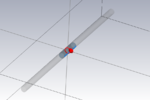emontemayor
Newbie level 4

Hi friends,
I am trying to simulate 2 dipole antennas in CST. Both dipoles utilize discrete ports as the source, with only one of them excited to achieve a TX-RX setup. I am interested in viewing the dB received by the RX antenna over a frequency range of 1GHz-10GHz. I am using the time domain solver. When the antennas are set up closer together the results are as expected, but once the distance is greater than 5ft the RX antennas does not receive any transmission. Is this a limit of CST itself, are there any settings I can tweak to get results at that distance, or is there something wrong with my setup?
Here are the parameters for the dipoles:

and one of the dipoles

I am trying to simulate 2 dipole antennas in CST. Both dipoles utilize discrete ports as the source, with only one of them excited to achieve a TX-RX setup. I am interested in viewing the dB received by the RX antenna over a frequency range of 1GHz-10GHz. I am using the time domain solver. When the antennas are set up closer together the results are as expected, but once the distance is greater than 5ft the RX antennas does not receive any transmission. Is this a limit of CST itself, are there any settings I can tweak to get results at that distance, or is there something wrong with my setup?
Here are the parameters for the dipoles:
and one of the dipoles








